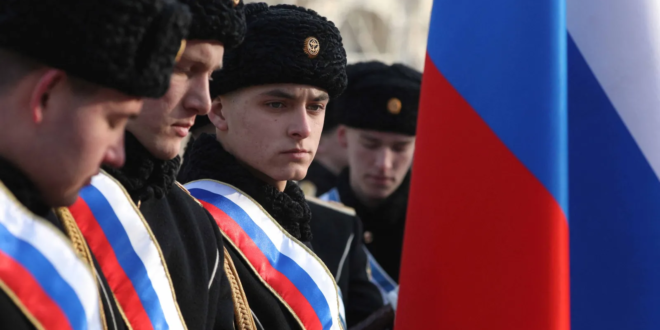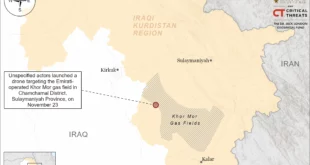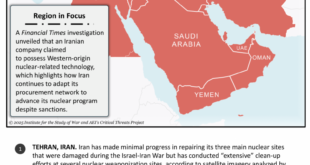President Donald Trump’s approach to Russia and Ukraine—deferring to Moscow, bullying Kyiv—may seem like a radical departure from precedent. In fact, it is only Trump’s extreme style of diplomacy that is novel, as exemplified by the public scolding he meted out to Ukrainian President Volodymyr Zelensky in the Oval Office in February. No American president has ever so publicly taken Russia’s side against one of Washington’s European partners.
But the administration’s broader approach to the region is nothing new. Every U.S. president over more than a quarter century has accommodated Moscow, with consistently bad outcomes. Call it “Russia first”: over three decades and six presidential administrations, Washington has sought to normalize or improve relations with Moscow, accommodating the Kremlin at the expense of other former Soviet states. Time and again, this policy of engagement effectively rewarded Russian revanchism. A series of “resets” with Moscow failed to produce long-term stability and encouraged Russia’s mounting aggression.
Today, Russian President Vladimir Putin has little incentive to negotiate in good faith or to reciprocate any de-escalatory measures taken by Ukraine, as Washington has repeatedly shown itself willing to cater to Moscow’s preferences. Even at the height of the Biden administration’s mobilization of political and military support for Ukraine, a low point in U.S.-Russian relations, Washington opted to pursue a policy of “escalation management,” needlessly holding back material assistance to Ukraine for fear of provoking Russia.
The early actions of the second Trump administration signal not a departure from the norm but an overt and enthusiastic embrace of the “Russia first” tradition. Instead of enhancing U.S. security through stronger alliances and more balanced burden sharing with European partners, the administration is banking that another reset will succeed where previous ones failed. Ignoring the lessons of history, Trump hopes to navigate U.S.-Russian relations and secure international stability by selectively yielding to Putin’s interests in Europe. That approach didn’t work for previous administrations, and it won’t work now.
SAME AS IT EVER WAS
To understand how U.S. foreign policy has arrived at this point, it is essential to examine the broader trajectory of post–Cold War geopolitics. After the Soviet Union collapsed in 1991, the United States prioritized security across eastern Europe and the former Soviet states, followed by democratic reform and economic stabilization efforts. Washington pursued these efforts under the belief that integrating former Warsaw Pact states and Soviet republics into Western institutions would prevent future conflicts. This period saw landmark agreements such as the Budapest Memorandum of 1994, in which Ukraine agreed to relinquish its nuclear arsenal in exchange for a path to Western integration and security assurances from the United States, the United Kingdom, and Russia—obligations that Moscow reneged on and that Washington and London failed to fulfill after Russia’s annexation of Crimea in 2014 and its full-scale invasion of Ukraine in 2022.
As Russia tried to find its way forward in the wake of the Soviet Union’s disintegration, Washington’s pursuit of security and democratization efforts clashed with Moscow’s ambitions to preserve its power and influence. Many states once dominated by Moscow pursued closer ties with the West, in part to protect themselves against future Russian empire-building. Against this backdrop, Washington’s efforts to maintain stable relations with Moscow became increasingly contradictory. The Clinton administration allowed former Soviet satellite states into NATO while reassuring Moscow that its interests and perspectives would be accommodated by the alliance; the 1997 NATO-Russia Founding Act outlined areas of cooperation and treated Russia as an equal. This bifurcated approach fed Russia’s sense of exceptionalism and laid the groundwork for future tensions.
By the mid-2000s, Russia’s resurgence, facilitated in part by surging commodity prices, signaled a more aggressive posture toward its neighbors. Moscow stepped up its economic coercion, political meddling, and military aggression to stymie its neighbors’ progress toward democracy and European integration. In 2004, the Kremlin intervened in Ukraine’s presidential election, backing the corrupt prime minister, Viktor Yanukovych. After Yanukovych was declared the winner amid credible reports of fraud and voter intimidation, Ukraine erupted in a series of mass protests that came to be known as the Orange Revolution. A rerun of the election resulted in the victory of the pro-Western candidate, Viktor Yushchenko. Four years later, Russia invaded Georgia, where it still occupies the regions of Abkhazia and South Ossetia and exerts influence over Tbilisi, the capital.
The Obama administration’s 2009 reset with Moscow, just months after Russia’s invasion of Georgia, is a striking example of this pattern of accommodation. The reset was meant to mollify Putin and deter further aggression by creating new avenues for economic and security cooperation. Obama’s efforts delivered one significant practical result: a new nuclear arms control accord called the New START treaty. But they did little to stifle Russia’s revanchism. Throughout his presidency, Obama privileged de-escalation and engagement over confrontation. This approach only emboldened the Kremlin and gave Putin a sense of impunity. Even after Russia annexed Crimea in 2014, the Obama administration declined to impose significant sanctions on Moscow or supply military support to Ukraine.
A series of “resets” with Moscow failed to produce long-term stability.In his first term, Trump expanded Russian sanctions and shipped some arms to Ukraine, but he also made overtures of friendship to Putin, leaving both U.S. allies and adversaries uncertain about Washington’s intentions. This inconsistent approach did little to deter Moscow from pursuing military aggression in Ukraine.
When President Joe Biden took office in 2021, he made clear that he saw Russia as an adversary but delivered only minimal material support to Ukraine. In the fall of that year in early 2022, as Russia built up its forces along its border with Ukraine, Biden made public U.S. intelligence that revealed Putin’s intention to invade. But he declined to increase the number of U.S. troops stationed in Europe or to arm Ukraine with advanced weapons systems, such as ATACMS missiles, HIMARS rockets, tanks, and artillery—steps that might have changed Putin’s mind.
After Russia launched its full-scale invasion, Biden denounced Putin as a “butcher” who “cannot remain in power” and pledged to defend “every inch” of NATO territory if the war escalated. But the rhetorical flourishes did not translate into practical policies when they were most needed. For too long, the administration accepted Russian rhetoric regarding “red lines” and took Putin’s nuclear threats at face value. By trickling in aid, placing restrictions on the operating range of U.S.-supplied weapons, and designating certain strategic targets as off-limits, the administration allowed the Russian military to gain its footing and move assets out of harm’s way. By the time Biden finally agreed to send Kyiv advanced weapons systems, it was too little, too late.
Biden had pulled back from the “Russia first” tradition, rallying allies to support Ukraine, but he didn’t break with it. Nothing the administration did or threatened to do compelled Moscow to engage in good-faith peace negotiations. Putin remained undeterred, in part because Biden failed to demonstrate an unambiguous commitment to Ukraine’s battlefield victory. Moreover, by 2022, Putin had come to regard Washington as fickle. Three decades of the United States’ “Russia first” approach taught him that time was on his side. The United States would eventually grow tired or afraid and prioritize de-escalation; then he could press forward and ultimately win. All he had to do, Putin concluded, was wait.
DEALMAKING AND DETERRENCE
Trump came into office promising to end the war quickly, and if there had been any doubt, it soon became clear that in his eyes, this meant coercing Ukraine into capitulating and accepting Russia’s conditions. That was the meaning of his Oval Office outburst at Zelensky. In recent weeks, Trump has continued negotiating with Russia even as Putin refrains from making any clear concessions. Trump’s special envoy Steve Witkoff told the commentator Tucker Carlson that he did not “regard Putin as a bad guy” and endorsed sham referendums held in regions of Ukraine under Russian occupation. And on Tuesday, as part of a U.S.-brokered deal to pause fighting in the Black Sea, Washington promised to help lift Western sanctions on Russia’s agricultural and fertilizer exports.
But some members of Trump’s national security team know that a weak Ukraine is not in the United States’ interest. A Ukrainian defeat would generate considerable political turmoil in Kyiv and undermine a durable peace in the region. Additionally, it would raise the prospect of Russian aggression against NATO’s Baltic flank. By securing Ukraine’s strategic position in negotiations, the United States can achieve a significant diplomatic victory, end the conflict, and deter future Russian aggression—all of which would serve U.S. interests in Europe.
Trump may yet realize that Putin is manipulating him and change course. Trump’s national security advisers must help him to see that if Ukraine is forced into a cease-fire without security guarantees, Moscow will simply use the pause to rearm and launch renewed offensives—much as it did after the Minsk agreements, the peace accords signed in 2014 and 2015 to end the fighting in Donbas after Russia’s limited invasion. To avoid that outcome, the United States and Europe must establish long-term security commitments to Ukraine and ensure that Kyiv is not left vulnerable to future aggression.
Putting “Russia first” has emboldened the Kremlin.In the short term, the Trump administration’s transactional approach could yield some benefits for both Ukraine and the United States. One of the key areas of economic and security cooperation between Washington and Kyiv should be Ukraine’s rare-earth mineral resources. Washington and its allies must explore agreements that allow Ukraine to leverage these vast reserves as part of long-term trade and security partnerships. By securing a reliable supply of these critical materials, the United States can strengthen its own industrial base while ensuring that Ukraine has economic leverage to sustain its independence.
But dealmaking can’t be the only way for Washington and Kyiv to work with each other. The periods of greatest cooperation between the United States and Ukraine have historically occurred when the two countries’ shared values and strategic interests aligned. In the 1990s, the two countries sought economic integration and security cooperation, resulting in major progress in nuclear nonproliferation and the introduction of a market economy in Ukraine. Learning from this history, future policy must emphasize the intersection of values and strategic interests to sustain long-term commitments that go beyond short-term transactionalism.
To arrive at a lasting peace, Washington must maintain leverage over Ukraine, Europe, and Russia in ways that serve the United States’ long-term economic and security interests. Policymakers in the Trump administration should push Kyiv to adopt broad anti-corruption reforms and ensure U.S. market access and rights to rare earth minerals. In exchange, Kyiv could continue to receive military aid, as well as access to additional funds for reconstruction and development. For their part, the Europeans must rebalance the burden-sharing for security and defense; Europe must assume the lead security role on the continent.And Moscow needs to end decades of malign influence, hybrid warfare, and military aggression before relations with the West can be normalized.
Thus far, the Trump administration has escalated pressure mainly on Ukraine, going so far as to pause economic and military support to Kyiv. This approach is counterproductive. The reality is that the Ukrainian leadership has and will bend over backwards to accommodate Washington, whose support it desperately needs, whereas the Kremlin remains intransigent and will only negotiate if compelled to do so. Applying excessive pressure to Kyiv while going soft on Moscow undermines the possibility of a long-term settlement that could deter further Russian belligerence.
PEACE THROUGH STRENGTH
For too long, the United States has treated both Moscow and Kyiv on the basis of short-term cost-benefit calculations, prioritizing momentary stability over long-term credibility. This approach has reduced tensions, but at the cost of regional stability and U.S. interests. Putting “Russia first” has emboldened the Kremlin and left the United States and its European allies less secure. The Trump administration must move beyond the myopia that has defined American policy for decades and prioritize long-term stability over short-term tactical gains. Abandoning Ukraine and weakening NATO would not just undermine European security—it would threaten U.S. national security by emboldening adversaries and reducing global stability.
The Trump administration should escalate sanctions on Moscow and step up military aid for Ukraine. Washington must maintain its resolve in the face of Putin’s nuclear saber rattling, push the Russian economy to the precipice, and help Kyiv achieve the battlefield successes necessary to force Moscow to negotiate. The key to achieving a peace settlement is for Ukraine to enter negotiations from a position of strength, Russia from a position of weakness, and the United States in a position of influence over both parties.
 Eurasia Press & News
Eurasia Press & News



